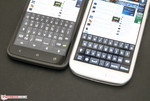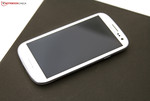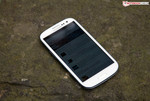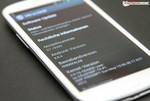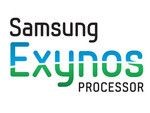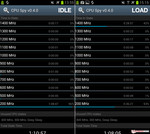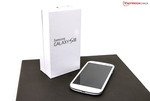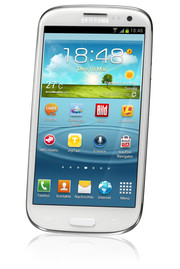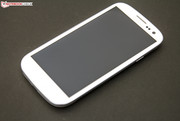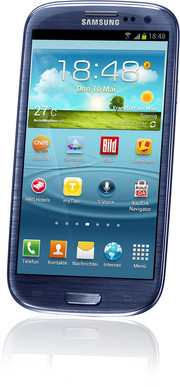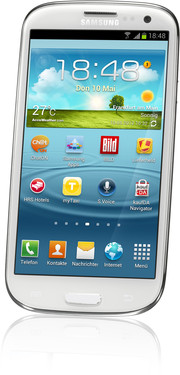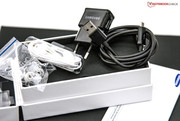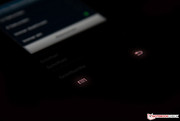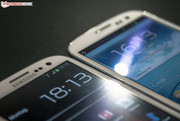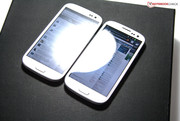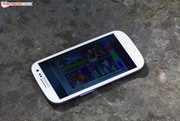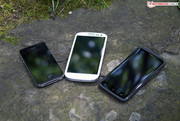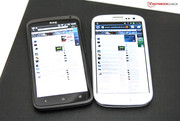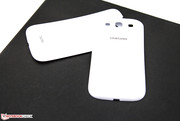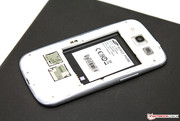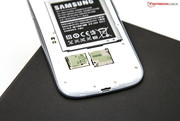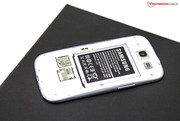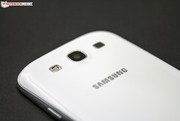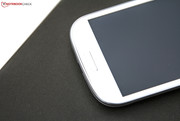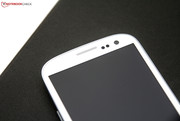Review Samsung Galaxy S3 (GT-I9300) Smartphone

For the original German review, see here.
Samsung's Galaxy S3, aka GT-I9300, is the third edition of its top model that the South Korean company launches on the fast-paced Android smartphone market. The first generation (GT-I9000) was debuted early 2010 and has been continuously refined since then. With a 4.8-inch HD Super AMOLED screen, quad-core SoC from Samsung and a fresh design, the smartphone competes against HTC's One X or LG's recently introduced Optimus 4C HD among others. Apple's iPhone 4S is virtually an old, but tried, hat compared with the newest Android flagship.
The Galaxy S3 has not only grown, but it is now also slimmer. The new polycarbonate chassis is meant to make a lasting first impression. Besides the usual high-end components, features such as NFC (near-field communication), a big battery, micro SD card reader and the special software functions augment the Samsung. As for software, the preinstalled Android 4.0.4 operating system is beefed up by the advanced TouchWiz 5.0 interface. Interested? We are heading for the premium range with a price from 599 Euros (~$784, RRP, 16 GB). Two color versions are available with Pebble Blue (dark blue) and Marble White (cream white).
Case
Samsung sticks to its line and relies on a multi-component casing made of polycarbonate with a removable back cover. The exchangeable battery and the option of inserting a memory card are advantages of this design. On the other hand, the single parts also increase susceptibility for flaws. HTC builds the One X in a polycarbonate unibody casing that made a higher quality impression in the review. In a direct comparison, HTC's chassis seems more angular and offers a different feel due to its roughened surfaces. The Galaxy S3's high-gloss back cover seems to have a better grip, but it is also more prone to scratches and fingerprints. These are noticed particularly on the blue version. The thin build of the cover may seem fragile but it is well manufactured. In our opinion, the Galaxy's combination of feel, rounder casing and slim build make it more pleasant to hold. Neither smartphone can compete with the material impression of Apple's iPhone 4S.
According to a few rumors prior to the official launch, the Galaxy S3 was allegedly developed with the company's legal department in order to evade further disputes with Apple. One result could be the available colors. Besides a white model (Marble White), the smartphone is also sold in a color dubbed Pebble Blue (dark blue). A black model is no longer offered. The Galaxy S3 is impressive in terms of stability and stiffness. We did not ascertain any creaking noises and the back cover resists selective pressure. Another bonus point is the primary camera protrudes only slightly. The one in HTC's One X clearly juts out and its lens had a few scratches within a short time.
The design makes a consistent impression. A silver rim adorns the sides and sets an elegant contrast. Both the front and the back are plain. Apart from the single physical button, touch buttons are found on its right and left that are only illuminated when in use. The light of these keys can be modified in the settings. A proximity sensor is also visible next to the front-facing camera above the white model's screen. Another feature is a message LED that can display different colors. This feature can also be customized.
We naturally compared the dimensions and weight. With a size of 137 x 71 x 8.6 millimeters (~5.4 x 2.8 x 0.34 inches, w x d x h), Samsung's Galaxy S3 is somewhat longer and broader as well as thinner than HTC's One X. Apple's iPhone 4S makes an almost bulky impression with its height of 9.3 millimeters (~0.37 inches) in comparison (+0.7 millimeters / difference: 8.1%). The three devices virtually weigh the same (133, 134 and 140 grams (~4.70, 4.73 and 4.94 ounces) in the same order). Only the Galaxy S2 as the test device's precursor is lighter with 116 grams (~4.09 ounces, difference: 12.8%).
Connectivity
The sides of the Galaxy S3 follow the motto less is more. As usual, the volume rocker is on the casing's left. Samsung installs the power button on the opposite side. Samsung's positioning seems to make more sense compared with HTC's One X. The button was already located here in Samsung's preceding models. The button is easier to reach particularly with the increasing size. This criticism cannot be transferred to smaller and handier devices such as Apple's iPhone 4S or HTC's One S.
On the Galaxy S3 we find a micro USB 2.0 port on the bottom, which enables sharing audio and video material via MHL-HDMI (mobile high definition link). The smartphone is also recharged over this port. However, a special, not included adapter is needed for video transmission. Samsung places the 3.5 mm stereo jack on the top. All functions except for volume control could be used with a headset with controls for Apple's mobile devices. An integrated microphone is also found on the top and the bottom.
Samsung's smartphone does not differ much from HTC's One X up to this point. However, the Galaxy's back cover can be removed. Underneath it, not only the micro SIM slot is found but also a micro SD card reader (SD, SDHC, SDCX). It supports a capacity of up to 64 GB, which would result in a gross capacity of 80 GB. Only 11.02 GB of the 16 GB internal memory are available for free use ex-factory. Even up to 128 GB of internal memory are possible should the buyer opt for the biggest, 64 GB Galaxy S3 model (RRP: 799 Euros/~$1046). If that is not enough storage, Samsung offers all buyers 50 GB of free Dropbox Cloud storage for 24 months. HTC cannot keep up in this point either as it "only" offers 25 GB. It does not matter whether it is an existing or a new account regardless of the device.
Communication
The communication options are correspondingly extensive. A basic component is the integrated Wi-Fi module that supports transmitting in both 2.4 and 5.0 GHz using 802.11 a/b/g/n standards. Bluetooth 4.0 is also an included wireless feature. It enables sharing data faster and corresponding end devices consume considerably less power with this new standard. Samsung's Galaxy S3 is suitable for most networks in the world because is supports the four main GSM frequencies (quad-band, 850/900/1800/1900 MHz).
A modern smartphone must feature fast mobile Internet connection. HSPA+ (high-speed packet access) enables a maximum data rate of 21 Mbit per second. Samsung announced a model featuring the new LTE transmission standard (long-term evolution) during the introduction in London. However, it will first be available for the American and Asian market. Such a model was not announced for Germany seeing that corresponding data contracts would be far beyond the budget of most end consumers. HTC already presented an LTE version of the reviewed HTC One X to German customers. However, this model is only powered by a dual-core processor.
Another feature that should not be omitted in this premium model is NFC (near-field communication). This, for example, enables application contents to be transmitted between two devices with an NFC module. The feature is dubbed Android Beam and also works between two devices from different manufacturers. Another field of operation is file sharing via NFC and Wi-Fi Direct, which Samsung calls S Beam. This module however really only gets interesting with its option to pay for purchases without contact or to transfer money via contact with another NFC device. Samsung and the credit card company VISA were the main sponsors for the Olympic Games 2012 in London and it advertised exactly this possibility in a commercial.
Software
After turning on the phone for the first time, the user is faced with Google's Android 4.0.4 operating system, aka Ice Cream Sandwich (ICS), alongside the modified user interface. Samsung relies on its specially modified TouchWiz 5.0 Nature UX, which features numerous improvements compared with version 4.0. The interface looks very appealing and clearly arranged although the unlocking noise only pleases for a short time. It can be turned off in the system settings. One improvement is the option to look at the home screen widgets in a small preview. A few apps from Google and Samsung are preinstalled. Among them, for example, is ChatOn, an organizer app or the corresponding Dropbox app. Regrettably, Samsung also installs bloatware on the smartphone's internal storage. We found a newspaper app, delivery service app, hotel app, price comparison app and a taxi app. In our opinion, only the needed applications should be preinstalled and it should be up to the user otherwise.
We would also like to mention two interesting features in this part. S Voice is the counterpart to Apple's Siri speech control, which has moved into the iPhone 4S. S Voice is started by tapping the home button twice or a predefined speech command. Many questions were acknowledged in the practical test but, like Apple's Siri, it is more likely an expandable feature than a useful application in everyday use. Another feature is called Pop-Up Play and enables playing a video while surfing on the Internet or writing an SMS. The video is displayed in a small window and can be re-sized by tapping on the picture. The quad-core SoC's power pays off here.
Camera
Samsung installs two camera modules for good quality pictures. The primary camera has a resolution of 8 megapixels and enables recording videos in Full HD (1080p, 1920x1080 pixels). The implemented BSI sensor makes a four-time digital zoom and pictures in a size of 3264x2448 pixels possible and includes an auto-focus. The Korean smartphone uses the same module as Apple's iPhone 4S. Both phones also have an LED flash beside the primary camera in common. The colleagues from iFixit, known for very detailed tech-teardowns, provide more insights on the Galaxy S3's innards. A 1.9 megapixel front-facing camera (1280x960 pixels) for video calls or Skype is located above the screen. It records videos with 720p (1280x720 pixels).
Since there are not many differences in the technical configuration in the upper price category, software features are to provide added value. Samsung also offers other features than the usual settings. Besides continuous shooting with 3.3 frames per second, HDR pictures can be taken. After a burst shot, the Galaxy S3 automatically submits the "best" picture. The immediate shutter response also has to be mentioned. Specific Samsung features are smile recognition and social tagging. A person can be tagged on a picture after taking a shot of friends or family. The smartphone recognizes this person in future photos and enables using the selected presentation of the pictures with the corresponding function. As the name indicates, this function is also linked to social networks like Facebook.
All three primary cameras of the smartphones shot good pictures without enabled zoom in the practical test. The reference pictures were again taken with a Canon EOS 60D with 18 megapixels. The quality of all three modules decreases when digital zoom is used. There are barely any visible differences between the Galaxy S3, HTC One X and Apple iPhone 4S in a direct comparison. Overall, the test phone provides a good reproduction performance when the zoom is not used. Smartphones are no longer inferior to cheap digital cameras due to different modes and supplementary functions. Regrettably, it is not possible to use the power button as the shutter button when the camera is active anymore. However, the zoom can be adjusted via the volume rocker.
Accessories
The new smartphone is found after breaking two seals on the box. One level lower, we find a few documents, a comparatively big, 2100 mAh lithium-ion battery, an in-ear stereo headset from Samsung including six additional pads, a USB data cable and the modular USB power supply. Further accessories have to be bought optionally from Samsung. This product range, for example, includes a docking station with a charging slot for a second battery, an MHL-HDMI adapter, a so-called Smart Cover for protecting the device or an induction-charging cradle. The first accessories are available. Others have only been announced or are not yet available.
Warranty
Samsung includes a 12-month warranty on the Galaxy S3. Only 6 months are on the battery and accessories. Samsung had not yet stated details about warranty upgrades at the time of this review. Diverse online retailers and mobile service providers offer various warranty and insurance models.
Input Devices
The capacitive touchscreen of Samsung's Galaxy S3 responds accurately to the touch of the fingers and detects various multi-touch gestures. Pinch-to-zoom (two-finger zoom) or tap-to-zoom (double-click zoom) are only two of the possible gestures and are mostly used for Internet browsing. A virtual QWERTY keyboard is faded in automatically for writing emails or short messages. In contrast to HTC's One X, Samsung omits an additional row with direction arrows and thus the layout does not look as cramped. The keyboard consists of four rows with a large space bar at the lower end. An additional row is above the keyboard where words are suggested and useful characters are displayed. Swift typing is possible with a bit of practice. Another input option is dubbed T9 Trace and is the refinement of Samsung's swipe function. The right word is inserted by wiping over the keys. However, the editor did not acquire a taste for this feature in everyday use in such short time.
A physical button and two touch buttons are located below the screen. Particularly the home button is handy because the user does not always have to search for the power button on the side for a short wake up. In contrast, HTC omits such a button and relies on three touch buttons that cannot activate the screen when it is turned off.
Display
A real major innovation of the Galaxy S3 is its big 4.8-inch HD Super AMOLED screen. It has a fine resolution of 1280x720 pixels in a 16:9 aspect ratio and is supposed to be impressive with brilliant colors and rich black. Compared with HTC's One X, which has an SLCD2 IPS screen, the test phone's screen features a PenTile matrix. Here, one pixel does not consist of the three colors red, green and blue (RGB) but of red and blue. Green is located between the single pixels that share several pixels. This produces a higher resolution with fewer pixels and ultimately lowers costs. The IPS screen of HTC's One X can also display 720p natively and is principally the higher quality alternative. The pixel density of 306 dpi (SGS3) and 312 dpi (One X) are on a comparable level.
In a direct comparison with HTC's One X, a light bluish cast is also noticed on this AMOLED screen. Various screen modes are found in the system settings, which modify the color presentation to an extent. However, this is basically a matter of taste and familiarization. The colors look brilliant on both screens, although the color palette of HTC's One X makes a more natural impression. The varying color temperature is not noticed when the screen models are not compared directly with each other.
Following the basic information, we take a detailed look at the measured rates. This starts with the screen's brightness that we measured using Gossen Mavo Monitor. The maximum brightness is 153 cd/m² at an even illumination of 95%. The Galaxy S3 cannot place itself at the top position since HTC's One X is brighter with 464 cd/m². In contrast to the SLCD2, AMOLED screens do not need a separate LED light and thus the difference is not as severe subjectively. HTC's One X is overall a bit brighter but it does not look twice as bright. Looking at the smaller HTC One S with an AMOLED screen, we would have however expected more from the SGS3.
| |||||||||||||||||||||||||
Brightness Distribution: 95 %
Center on Battery: 147 cd/m²
Contrast: 4900:1 (Black: 0.03 cd/m²)
The Galaxy shows its advantages in the other rates and convinced us with a very low black value of 0.03 cd/m² and extremely high contrast of 4900:1. The contender from HTC cannot compete with that and has to admit defeat. The subjective image sharpness and the screen's available contrast also look good.
Strong opponents face each other in outdoor use. On the one side, the glossy-type display surface and moderate brightness of the AMOLED screen and on the other, a low black value and extremely high contrast. The screen is compelling in the shade or indoors in an indirect light source. The content is still legible in direct sunlight but the reflections on the surface limits outdoor use. Samsung would have perhaps created the perfect smartphone outdoor display with higher brightness rates. We applied a matte screen protector for comparison. Apart from the familiar, annoying application, the matte surface pays off and also conveys a different feel. However, the maximum brightness is not available with such a protector.
Performance
Besides a fine screen resolution, a high-performance processor is a must have for a 2012 smartphone. Samsung follows this trend and installs an Exynos 4 quad-core system-on-a-chip (SoC) with a clock of 1.4 GHz from its own production range in the Galaxy S3. To be precise, it is the Exynos 4412 featuring a structure width of 32 nanometers and is based on the ARMv7 architecture with a Cortex A9 quad-core processor. It also sports 1024 MB of LPDDR2 working memory and 16 GB of storage, which can be expanded via a micro SD memory card as mentioned earlier.
The ARM Mali-400 MP4 GPU, which features four Fragmen processors in the maximum configuration, takes care of graphics. It is a part of the Exynos 4 quad-core SoC and clocks with 440 MHz. The chip has to compete with Nvidia's Tegra 3 SoC in HTC's One X in the following benchmarks. Regrettably, Samsung does not use the newer Mali-T604 GPU. However, we first looked at the SoC's clock behavior via CPU Spy before we performed the performance comparison. The system usually works with energy-efficient 200 MHz in normal use. During load (Stability Test), the SoC's maximum clock is used to approximately 40%. Nvidia's Tegra 3 chip in HTC's One X has a clear advantage in idle because it mostly works with 100 MHz and thus consumes less power. But more about that later.
We sent the smartphone through our exhaustive Android benchmark course to adequately compare the performance. Samsung's Galaxy S3 and HTC's One X were neck and neck in the first part. The Galaxy clearly took the lead in both Google V8 Benchmark and Browsermark with 29% and 39%. The Galaxy S3 also won the Sunspider benchmark. In contrast, the One X won the Smartbench 2012 and Linpack (multi-CPU) benchmarks. The rates of the Galaxy S3 visibly fluctuated in the latter and thus we determined the average from ten measurements. The maximum rate was 183.3 MFLOPS and consequently about 40% in front of HTC's contender. Apple's iPhone 4S can barely keep pace in the browser-based benchmarks. The iPhone only presented a convincing score in the Sunspider benchmark. However, we should keep Apple's end-to-end concept with specially modified apps for the end devices and the resulting routine performance in mind.
| Google V8 Ver. 6 - --- (sort by value) | |
| Samsung Galaxy S3 | |
| HTC One X | |
| Apple iPhone 4S | |
| Sunspider - 0.9.1 Total Score (sort by value) | |
| Samsung Galaxy S3 | |
| HTC One X | |
| Apple iPhone 4S | |
* ... smaller is better
| Browsermark 1.0 - --- (sort by value) | |
| Samsung Galaxy S3 | |
| HTC One X | |
| Apple iPhone 4S | |
| Linpack Android / IOS - Multi Thread (sort by value) | |
| Samsung Galaxy S3 | |
| HTC One X | |
| Smartbench 2012 | |
| Productivity Index (sort by value) | |
| Samsung Galaxy S3 | |
| HTC One X | |
| Gaming Index (sort by value) | |
| Samsung Galaxy S3 | |
| HTC One X | |
We finished our course with the GL benchmark version 2.1, which is an important test that contains many frequencies with different focal points and settings. A special focus should be placed on the Egypt and Pro tests.
Egypt is a test that primarily rates gaming performance. The standard setting performs tests in the screen's native resolution and thus the results are not always comparable. The Egypt off-screen benchmark executes the test in 720p (1280x720 pixels) regardless of the screen. The Galaxy S3 is roughly a third faster than HTC's One X with 100 frames per second (fps).
The smartphone shows a comparably good result in the Pro benchmark. However, the OpenGL performance is rated in comparison (pipelines & shaders). HTC's One X is defeated in this test with 91 to 127 frames per second (difference: 28%).
| NenaMark2 - --- (sort by value) | |
| Samsung Galaxy S3 | |
| HTC One X | |
| Basemark ES 2.0 - Taiji Free (sort by value) | |
| Samsung Galaxy S3 | |
| HTC One X | |
| GLBenchmark 2.1 | |
| Pro (sort by value) | |
| Samsung Galaxy S3 | |
| HTC One X | |
| Pro Offscreen (720p) (sort by value) | |
| Samsung Galaxy S3 | |
| HTC One X | |
| Egypt (sort by value) | |
| Samsung Galaxy S3 | |
| HTC One X | |
| Egypt Offscreen (720p) (sort by value) | |
| Samsung Galaxy S3 | |
| HTC One X | |
In summary, Samsung's Galaxy S3 wins most benchmarks although partly with only a marginal advantage over HTC's One X. However, there is always the question to what extent the performance of a quad-core SoC is worthwhile in everyday use. Subjectively, the OS runs extremely smooth. In comparison, it is perhaps even somewhat faster and more pleasant than the Sense UI 4.0 from HTC. The pure graphics performance is still likely only an advantage in demanding 3D games. A dual-core SoC would suffice for routine Internet browsing or other basic functions of a smartphone.
Emissions
Temperature
The Galaxy S3's hardware is only cooled passively over the casing so the temperature surrounding the chassis is a factor. The components barely generate any heat when idling and the polycarbonate casing remains pleasantly tempered with a maximum of 26.7 degrees Celsius (80.06 Fahrenheit). The waste heat increases during load and the device's temperature climbs noticeably to a maximum of 46.1 degrees Celsius (114.98 Fahrenheit/stress test). However, the device does not get this warm when playing up-to-date games for long sessions and holding it in the hand is no problem even for extended periods. HTC's One X exhibits a higher maximum temperature of 52.8 degrees Celsius (127.04 Fahrenheit).
(+) The maximum temperature on the upper side is 37.2 °C / 99 F, compared to the average of 35.2 °C / 95 F, ranging from 21.9 to 247 °C for the class Smartphone.
(-) The bottom heats up to a maximum of 46.1 °C / 115 F, compared to the average of 34 °C / 93 F
(+) In idle usage, the average temperature for the upper side is 25.7 °C / 78 F, compared to the device average of 32.9 °C / 91 F.
Speakers
The integrated speaker is located on the primary camera's right. Considering the size, the sound quality makes a good impression. The volume is more than sufficient and the high pitches are rendered clearly. The low pitches as well as bass exist to a minor extent but we would nevertheless recommend using high-quality headphones for music enjoyment. Samsung includes a white, in-ear headset model EHS64AVFWE for the Galaxy. The performance of this headset is surprising and due to six different ear pads, it can be made to fit every ear. Naturally, this solution cannot compete with Hi-Fi alternatives, but it doesn't have to anyway.
Energy Management
Power Consumption
Low power consumption is a prerequisite for good battery runtimes. Samsung's Exynos 4 Quad SoC and the other components prove to be real power-savers in our measurements. The system consumed between 1.2 and 1.5 Watts at idle and is thus on a par with HTC's One X. However, it is striking that HTC's smartphone exhibits a 50% lower minimum consumption of 0.6 Watts.
The consumption rates only climb marginally during load and reach their maximum at 3.4 Watts. HTC's One X consumes approximately 70% more power with a maximum of 5.8 Watts in this scenario. The Galaxy's larger lithium-ion battery of 2100 mAh has an advantage over HTC's One X with 1800 mAh in the battery runtime assessment. Another advantage is that the battery in Samsung's smartphone can be exchanged when away from the mains for a longer time.
| Off / Standby | |
| Idle | |
| Load |
|
Key:
min: | |
Battery Runtime
The battery runtimes confirm the consumption rates. The larger battery and low consumption pay off in idle. Almost 16 hours are possible using minimum brightness and disabled wireless technologies. We deactivated the adaptive brightness for all tests. The higher consumption at the lower end compared to HTC's One X is however a disadvantage of the Galaxy S3. Despite the HTC One X's smaller battery, a full charge lasts approximately 90 minutes longer due to its lower clock of 100 MHz.
It looks different during load via the Stability Test in maximum brightness and enabled mobile technologies. The Galaxy S3's power consumption is lower at the peak and the 2100 mAh battery is bigger. This combination reaches a runtime of 4 hours and 29 minutes.
The assessment "Wi-Fi browsing" is a realistic scenario that we perform with 150 cd/m² to ensure wide-ranging comparability. Since this brightness rate is also the maximum brightness, the difference of four hours (8 hours and 22 minutes) is comparatively low. The 39 gram (~1.38 oz.) battery needs 2 hours and 42 minutes for a complete recharge via the modular power supply.
Verdict
After the preceding hype of the official introduction of Samsung's Galaxy S3 (GT-I9300) at a gigantic launch event in London, positive and negative voices were heard. Contrary to expectations, the smartphone did not feature a Full HD screen or a 12 megapixel primary camera. The design barely adopted any points of its precursor and a black model is no longer available. We found the Galaxy S3's looks pleasing and the option of replacing the battery and inserting a micro SD memory card are plus points. The polycarbonate casing is well processed but cannot compete with the unibody casing of HTC's One X or Apple's high-end materials. The plastic, aluminum-colored rim could also have been the real thing.
The big 4.8-inch HD Super AMOLED screen has a resolution of 1280x720 pixels and supplies both an excellent contrast and black value. The luminosity would have to be a bit brighter for perfect outdoor use. We could exhaustively contemplate about the PenTile matrix of the AMOLED screen compared with the SLCD2 in the One X. Without a direct comparison, this technical difference will be insignificant for most users. The performance of the Exynos 4 Quad SoC (Exynos 4412) proves to be ideal. The power is usually close to or clearly above the scores of Nvidia's Tegra 3 SoC. The integrated camera modules enable shooting high-resolution pictures in good quality although the digital zoom should be avoided.
The included 2100 mAh lithium-ion battery can deal with the Galaxy S3's power consumption and belongs to the biggest in this category. However, the efficiency of Nvidia's chip wins in idle. Samsung relies on Android 4.0.4 with an advanced TouchWiz interface in terms of software. Version 5.0 carries the good-sounding name Nature UX and underpins the Galaxy S3's "designed for humans" marketing slogan. The question remains for whom and for which target groups the former Samsung smartphones were designed.
Numerous software features are to make the decision on this fast-paced market easier. Just like Apple's Siri, S Voice works only to an extent in Germany and Smart Stay, Smart Alert or Direct Call are more nice-to-haves than must-haves. Altogether, Samsung undeniably delivers the new smartphone leader powered by Android OS with the Galaxy S3. It does many things right but also has a few shortcomings. Evolution rather than revolution.




















